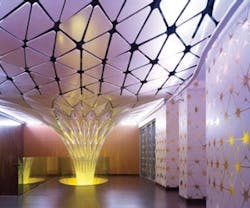Green interior materials abound, providing sustainable options for every interior space – from your floor to your ceiling and everything in between.
Ceilings offer a plethora of green choices, from natural mineral fibers to metals, ensuring that sustainable options for almost any facility are readily available.
“Ceilings are a very sustainable category overall because they’re highly recyclable. There are closed-loop processes that bring them back to manufacturers, where new ceilings are made,” explains Anita Snader, environmental sustainability manager for Armstrong Commercial Ceilings. This is similar to other industries, like carpet, where all (or at least portions) of the products are reclaimed and reused by manufacturers in making new products.
Unlike other product categories, however, there are no set industry standards for determining the greenness of different ceiling options. This means it is up to you (and your designer, architect, or green consultant) to determine your best option.
Greener Options
Ceilings can be made out of essentially any material, depending on your design, maintenance, and acoustical needs. According to architect Hagy Belzberg of Belzberg Architects, greener options include:
- Mineral fiber: Fiber panels are an eco-friendly option because they’re made of naturally occurring resources, so you’re not depleting the environment.
- Metal: Metal takes a long, intensive process to mine, mill, and fabricate. A lot of energy is expended into making metal products. However, a recycled metal paneling system is a great use of the material. A lot of energy goes into recycling metal too, but not as much as generating a new product from raw materials.
- Wood: While wood is renewable, it is not always a sustainable option. Locally and sustainably harvested products offer an eco-friendly alternative to more rare and imported woods. Bamboo is also a rapidly renewing resource, but is often harvested and then shipped long distances.
Even if you have your heart set on an unsustainable or non-renewable product, there are methods of making it greener. “Let’s say that somebody asks for teak,” says Belzberg. “We would go to a company that takes teak from barns and railroad tracks from Southeast Asia and remills them. So you’re not really depleting the natural environment, you’re really just taking from an existing building and recycling it. You have a nice, beautiful wood ceiling that no one would know came from a railroad track in Vietnam.”
Form vs. Function
In the realm of ceilings, it’s no longer a sacrifice between form and function. Today’s aesthetically pleasing ceilings can meet all of your space’s functional needs.
One of Belzberg’s recent projects, the Conga Room in Los Angeles, incorporates green paints to create a subtle, yet undeniably green, ceiling. “There’s a huge array of parametric patterned ceiling petals that were created for acoustical absorption and reflection of light,” Belzberg explains. “We made them out of formaldehyde-free, recycled MDF panes that we painted with a white soy paint product. That gave us all the attributes of a sustainable product; however, when you look at it, it looks like a white panel and you have no idea what its success really is.”
Green doesn’t necessarily mean acoustically inept, but sound in your green space deserves fair consideration. If you find that your ceiling is lacking in acoustical value, you can easily remedy that without sacrificing the space’s green points.
Armstrong experienced this after employees were unhappy about the acoustics in its LEED Platinum corporate headquarters building. Because the acoustics were of concern, the company opted to make improvements to the space with absorptive furniture panels and soundmasking. In fact, this method actually added to the company’s LEED credit total by giving extra points for innovation.
“When we were making choices to make the acoustics better, we were making the choices with green materials,” Snader explains. “We were making sure the ceiling had a high level of recycled content and was low emitting. When we did the furniture panels, we made sure that we weren’t blocking the daylighting.”
The extra work Armstrong (and other companies) put in is a small cost premium that is more than justified by happier, healthier tenants, as well as the soft benefits awarded to a greener building, such as its added value in the eyes of prospective tenants.
“Sustainability still is a little bit more expensive right now – about 10% more expensive,” Belzberg concludes. “But what you’re able to sell to your clients is a cleaner, more responsible environment that I think most people would appreciate.”
Kylie Wroblaski ([email protected]) is associate editor of BUILDINGS.
